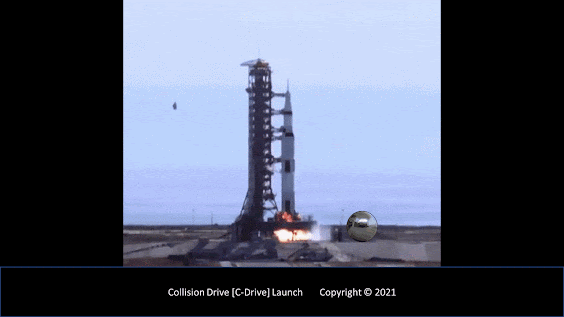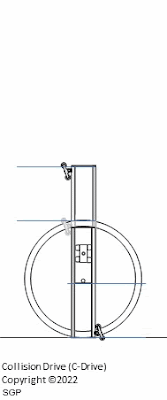It can sometimes be difficult to visualize how the collider arm of a C-Drive generates lift. There is a simple visual demonstrator that can be used to show how the collider arms work to independently lift a vehicle off the ground and generate flight. A C-Drive is technically a form of rocket propulsion. It uses a mass flow, however, this mass flow has distinguishing characteristics. The mass flow:
1. Is recycled. This means that though it provides motive force and propels the vehicle, unlike conventional mass flows that are gaseous or consist of ions, C-Drives do not eject any exhaust, they are zero emission.
2. Conventional propulsion systems use internal combustion as seen in ICE vehicles, rockets use combustion that is very low density that is often seen at launch sites where these gases are seen billowing from the bell shaped nozzle of rockets. They also use ions in the same way, except that ions can be considered super low density. Being super low density ions as a source of thrust are not practical for heavy lifting payloads into space, they are mostly practical for low level propulsion needs in space. Like EVs C-Drives can use motors and battery systems to generate the rpm required for the C-Drive to provide thrust or lift.
In this animation, instead of the collider arm rotating we have isolated it, restricting it to a lateral up and down motion which occurs during rotation. By isolating the collider arm in this way it becomes possible to see how it independently pushes the wing, in this case, directly upward to create lift. In this example the collider arm is isolated to show where it would go and the Circular Wing is instead moved to show how the collider arm would force it to shift its position. In this animated demonstration the Circular Wing is shifted upward by impacts from the collider arm. By the collider arm swinging to C, it lifts the Circular Wing to which the vehicle is attached from A to B consequently lifting the vehicle off the ground.
What is observed from the exterior is a rising spaceship, craft, vehicle or probe (ball) without any visible means of propulsion. This flight would be described as gravitational by outside observers, however, its movement and flight is not being caused by a manipulation of Space-Time as would be alluded to by Stage II levels of analysis. The isolated collider arms are generating the lift force C, and lifting the vehicle through A-B and A' to B' using twin collisions per 360 degree rotation (2CPR).
To generate this lift force in a uniform direction the counter rotating collider arms must switch polarity every 180 degrees (every half rotation). This lift force is shown being applied on the left side (inner collision) and right side (outer collision) of the C-Drive. This same lift force is demonstrated as lateral movement in the proof of concept results video.
All that observers see is the spacecraft or vehicle rising, in this case the a probe or silver ball with a hardened, reflective surface is observed "mysteriously" rising above ground, or moving mysteriously across the sky at a pace conventional propulsion systems have a hard time keeping up with. Whether these UAP sitings are real or illustrative (CGI) is a distraction, the focus is on what they can or appear to do, which is set the bar for propulsion technology higher and fact is that C-Drive technology is able to bridge that gap in real world terms.
The beauty of the flight demonstrator is that it leaves no doubt about the working mechanism of a C-Drive, the moving parts are open to see, the mechanism is self explanatory, its clean, readable, measurable, and the truth is that if you know enough about mechanics, engineering or rockets the animated demonstrator is sufficient information to appreciate the authenticity of this propulsion system. What you are being told about it is not hot air or overhyped rhetoric. This is especially important for the aerospace industry and investors. What C-Drives can do (see 11 efficiencies) is likely to be nothing short of revolutionary when it comes to aviation and propulsion the industry.
.gif) |
| If you compare the re-action force depicted by the red arrows shown above (C-D), which represent the collider arm or high density mass flow it travels downward continuously just like the gaseous burn emerging from the bell shaped nozzle of a rocket or jet engine, in this sense the C-Drive is really simply a kind of cutting edge rocket science or technology, see it in action using the proof of concept video. In terms of technology the C-Drive has advanced beyond rocket technology that ejects or emits a gas, it has also leap frogged ion propulsion technology and is sitting on the very cutting edge of what is possible in state of the art zero emission propulsion technology. Internal and external collisions are created by reversing polarity, upward thrust occurs during 360 degrees of rotation of counter rotating collider arms. This vehicle is in I-Formation. X-Formation is recommended for launches from earth as it exploits the downward pull of gravity converting it into upward lift. I-Formation is more suitable in Space. |
Imagine the ability to launch super heavy payloads into space, launch with much lower emissions, and do so with such widely improved cost efficiency that more business and countries can participate in the exploration and commercialization of space. Converting jet engines and rockets into sources of massive torque that can power C-Drives leaves the room wide open for collaboration and innovation. The thrust from a jet engine simply can't compete with the acceleration and thrust of a C-Drive, however, the torque from a jet engine applied through a C-Drive is a very powerful combination, which means there is plenty of latitude for collaboration.
Why field theory, which is the foundation of modern physics cannot design a C-Drive
Let's keep this as simple as possible. When a physicist says "field", what he or she is saying is "medium". For instance, a boat appears to float on water, the external medium or field is therefore water. A balloon appears to float in air, the medium or field is therefore air. Field theory requires an object to be suspended in or on a medium as the main pervasive characteristic of gravity. A space station or planet is suspended in Space-Time depicted by geometry or geodesics as the medium or field, as the balloon is suspended in and moved by air or the atmosphere, the planets and a space station are moved by the geometry of Space-Time. The assumption in physics that an object with mass must be suspended in Space by a field (medium) technically means that it is impossible to design a mechanism capable of suspending itself without a medium or without a field. This thought or philosophy makes it impossible to design a C-Drive, that is, you shouldn't bother because it can't be done - this problem has no solution. Therefore, to design a C-Drive you first have to change your philosophy to the fields do not exist (FDNEH) proposition. If an object can move and suspend itself without a medium (field) then what is the mechanism by which this movement, flight, self suspension or gravity achieved? In a C-Drive the collider arm does not qualify as a medium or field because it is an intrinsic part of the C-Drive or vehicle. If this solution or mechanism works (does not push off anything external to it to move) then it disproves field theory (to be moved or float an object requires a medium) and renders some of its assumptions flawed. The solution to this problem is the C-Drive. C-Drives prove that mechanical engineering can design a device capable of moving and suspending mass without the need for a medium (field) see the proof of concept video.
C-Drives prove that Space-Time geometry does not exist as a field, but rather a field effect
The difference between a "field" and a "field effect" is very subtle, however, if a scientist does not distinguish between the two he or she is very likely to have a flawed or tainted knowledge (Stage II) of gravity, space, time, the universe and how it works. Let's take something as simple as the magnetic field around a bar magnet. Does that field exist in and of itself? No. It can only be detected through a conduit e.g. iron filings. A scientist who understands that the interaction or communication (handshakes between the bar magnet and iron filings) causes the atoms of the iron filings to move into various positions around the bar magnet, under their own motive force recognizes that there is no field only a field effect (Stage III level of understanding). This complies with FDNEH. The scientist who believes the bar magnet is what moves the iron filings into various positions around the magnet, believes fields exist (Stage II). Similarly, Space-Time geometry does not exist, it is not a field, rather it is a field effect. For further reading see slingshot and the spandex experiment error.
Does light bend in strong gravity? Which school of thought do you belong to? Do you believe that a straw placed in water actually becomes bent, that is, strong gravity bends light as it passes near a black hole, Stage II? Or, if fields do not exist, do you understand that light bending is a field effect, that is, the light navigates (steers itself) when it interacts with a black hole, Stage III?
 |
C-Drives are a much bigger deal than Artificial Intelligence (AI). The demonstrator above shows that C-Drives and Rockets are both action re-action vehicles, however, having HD-SRMF and the 11 efficiencies makes C-Drives far more advanced. They introduce Tier 1 Gravity, Amplification in power generation, access to a completely new domain in the sciences based on their capacity to attain FTL. The gifts C-Drives come with are transformative for humanity, gifts that AI simply does not offer and cannot compete with for the status "of the next big thing". You're only the biggest and the baddest, until the biggest and the baddest arrives. |
 |
| Illustration of side by side launch of Rocket and C-Drive. |
The C-Drive ball shaped vessel and the rocket are both putting out similar amounts of thrust, however, in this case the C-Drive's mass flow or thrust is recycled, which means there is little or no exhaust.
Candidly, which of the two launch technologies do you think has a future?
Seriously, which technology and propulsion system between the two would you want to inspire your your company and team to advance to, in the next few years?
See the demonstrator animation above to understand how the ball shaped ship is able to rise alongside the rocket. In the top left corner of the animation you can see a recreation of the reaction forces (red arrows) from collisions of the collider arm against the circular wing being put out by the ball, that enable it to generate thrust, which are of course invisible.
 |
| Artistic top view:50m Super-cruiser |





No comments:
Post a Comment